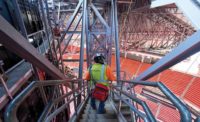China Grapples With Supertall Building Boom










The People's Republic of China is the center of tall building construction in the world. China has seven of the 10 tallest buildings in the world that are under construction. Yet China construction practices, even on closely scrutinized iconic supertall buildings, do not always meet U.S. quality and safety standards, said many high-rise construction experts, at a recent conference on tall buildings, organized by the Council on Tall Buildings & Urban Habitat.
That is one reason why it is somewhat comforting that China’s building codes are more conservative, agreed the tall-building experts. Overbuilt and redundant structures may cost more, use more material and take longer to build, but they may also provide an extra safety factor in the event of an earthquake, they said.
The new generation of larger and tall buildings comes with a host of issues for Chinese developers. “This is a huge challenge for us,” said Zhoahui Jia, technical director for Greenland Group, one of China’s biggest builders of tall buildings.
Supertall building development is “still not a mature business mode in China,” he added. “There have been both successful and regretful design practices” regarding tall buildings, he said. Greenland is developing the world’s tenth-tallest-building under construction—the 518-m Dalian Greenland Center in Dalian in northeast China. The tower’s anticipated completion is 2016.
The developer was one of 850 attendees of CTBUH 2012 which took place in Shanghai, from Sept. 19-21. The Chicago-based CTBUH held its ninth world congress, which it called Asia Ascending, at the Jin Mao conference center, connected to the 421-m Jin Mao Building.
The Jin Mao tower, completed in 1999, triggered China’s era of the supertall building. It is located in the Pudong Lujiazui Finance and Trade Zone, across the street from both China’s tallest completed tower—the 492-m-tall Shanghai World Financial Center— and the site of China’s next-tallest building—the emerging 632-m Shanghai Tower. Pudong is located across the HuangPu River from the historic Bund and the sprawling city’s downtown. Shanghai's population is 23 million.
Tall Progress
The business may not be mature, but still, there has been much progress producing tall buildings in China, say the experts. For example, China’s first high-rise, topping 100 m, went up in Shenzhen in the 1980s. For that building, steel was imported from Japan and steel erectors were trained in Japan, said Li Guo Qiang, a professor of civil engineering at Tongji University, Shanghai.
“China had no experience then,” said Li. The situation “has improved.” Steel is no longer imported; the work force is better trained and more engineers and architects are experienced in tall building and in seismic design, he added.
Political Clouds











